Introduction
Until recently I knew very little about my
grandparents, Clarence Earl ("Dutch") and Hazel Hulburd. Hazel
passed away in 1944, a year before I was born, and "Grandpa Dutch" died
in 1952 when I was not quite 7 years old.
I've been told that he
periodically traveled from St. Louis to visit my family in New
Jersey when I was very young but I have almost no recollection of him.
I thus really never knew my grandparents and my mother, Betty
Hulburd-Hine-Alderson, never talked about her parents much, at least
partly because they were not around to be part of our lives as I grew up.
In recently going through family information stored
for years by my deceased mother I came upon a wealth of information
regarding my grandparents which I didn't know existed including
photographs, letters, newspaper clippings, etc. The
letters in particular, which were mostly written by Dutch, provide a
treasure trove of information about the Hulburd family. From this recently
discovered material along with what was already known from the limited
oral history passed down in the family and from recorded family history
discussions with mother I have been able to put together the following
biography.
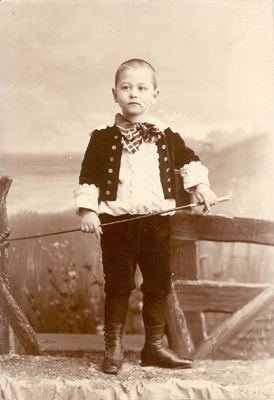 |
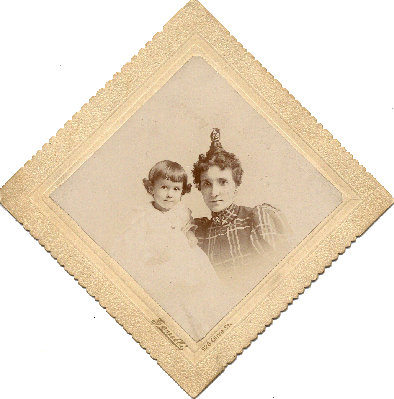 |
|
Dutch Hulburd in 1892 |
Hazel
Coudy with her mother
Harriet Shipley-Coudy around 1895 |
| |
|
About Hazel Coudy-Hulburd
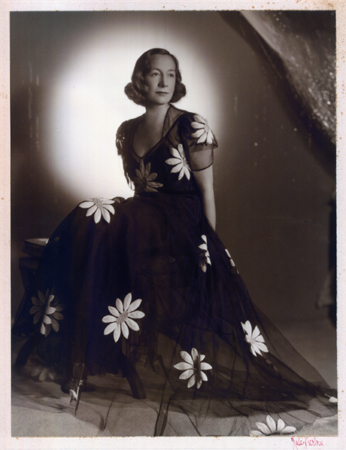 |
| Hazel in the mid 1930's |
Little is know about Hazel's childhood. She
was born May 15, 1893 in St. Louis Missouri, the daughter of Horace R.
Coudy, an accountant for a railroad, and Harriet Varner Shipley-Coudy.
She grew up in St. Louis along with her brothers Norman, Harold, Elmer,
and perhaps Raymond (who is mentioned in surviving papers by my mother
but who shows up in no other family records).
In a 1986 recorded oral history interview my mother refers to her mother as
being 4'10" tall and having red hair. Mother indicated that
Hazel did not attend college. I have no information on what her
hobbies and interests were and don't recall her having a nickname
(mother always called her "mother") so I presume she was known to her
friends as Hazel. My mother never had a
bad thing to say about her mother but also didn't mention her much.
Photos in a surviving album
containing images of Hazel as a teenager and/or young adult before her
marriage suggest that she was likely social and outgoing and had a
number of friends.

| |
|
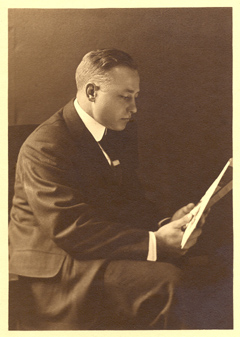 |
|
A young Dutch Hulburd - date
unknown |
|
|
About C. Earl Hulburd
Clarence Earl Hulburd was known as "Dutch" to his close friends and
used the formal name "C. Earl Hulburd". He was born on
May 12, 1888 in Moberly, a mid Missouri railroad town, where his birth
certificate indicates that his father, Henry E. Hulburd, worked as a
machinist.
Sometime after Dutch's birth the Hulburd family moved to
Ferguson, Missouri, a close-in suburb of St. Louis. The
exact time of the move is not known but the family is known to be living
in Ferguson by about 1904 (according to an obituary for Dutch's
grandfather, Fernando Knowles). Cryptic handwritten notes taken by
my mother from a conversation with Ernie Hulburd (Dutch's uncle)
regarding the family read: "went to Ferguson
for dad's health, frail baby" suggesting that perhaps the family moved
shortly after Dutch's birth. In 1889 Dutch's father became
employed as a clerk for the Railway Mail Service and this new job could have
been a result of the move. In any case, my best guess is that
Dutch spent most of his youth in St. Louis (Ferguson). He grew up
as an only child thought he apparently had two sisters, both of whom died in
their infancy.
 |
| Dutch in
1907 at age 19. |
| |
According to
oral history passed on from my mother, Dutch attended Washington
University in St. Louis and later "business school" at the University of
St. Louis (perhaps night school). It is not known whether or
when he graduated nor what degrees were earned. Other then what I
was told by mother, I have found no evidence that he attended college though
from his surviving writings it is clear that he was well educated.
I recall mother once
mentioning that her father was an accomplished amateur Ragtime piano player.
In the early 1900's Ragtime was a popular form of music with roots in St.
Louis. Dutch knew how to use a typewriter, a talent that most men of
his day didn't have, as evidenced by his numerous typed letters which have
survived. He was also apparently an amateur poet and some of his
typed poems to his son and mother survive. Certificates included
with his surviving papers include one documenting his induction on April
21, 1923 as "Master of the Royal Secret of the 32 Degrees and Accepted
Scottish Rite" (I believe this organization was referred to as
"Masons") and on February 12, 1931 he
became a member of the National Society of the Children of the American
Revolution.
Photographs of Dutch as a young man suggest
that he was likely very social, had a lot of friends, and took part in sports
and other outdoor
activities. Surviving notes suggest that he may have played high
school
football in Ferguson. All evidence suggests that
Dutch through out his life had great wit, was very outgoing, social and
likable, was active in community and
political affairs, was a good communicator, and had many, many friends.
About the Hulburd Family

 |
| Hazel,
Betty, and Harriet about 1920 |
Dutch and Hazel were married on July 3, 1915 in St. Louis. Mother recalls on her recorded family oral history tapes that her
family had lived with Dutch's father and mother (Henry and Ella Hulburd)
for a time in Ferguson when she was about 6 months
old. This would have been around 1917. Later her family lived
at 721 Limit Ave, University City (another St. Louis suburb) and 7629 Wydown (St. Louis) when she was about 8 years old (circa 1925).
Sometime around the mid to late 1920's the family moved into the very large
home they would occupy till 1939 at 78 Vandeventer Place in a very
exclusive St. Louis neighborhood.
An announcement of the birth of Hazel and Earl Hulburd's first
child, Harriet, appears in a worship service publication of the King's
Highway Presbyterian Church (St. Louis) dated April 16, 1916.
This, along with records showing that their second daughter, Betty (born
in 1917), was a member
of this church as she was growing up suggest that Hazel and Earl were
Presbyterians. The Hulburds had a third child, Bud, born in 1928.
| |
 |
| |
Date and location unknown but
could be the 1920's or early 1930's at Dutch's Collier
Estate office.
|
Dutch, after working several jobs, the specifics of which have been
lost, obtained the position of the Secretary of the Collier Estate which
cared for the financial assets of the estate of a very wealthy St. Louis
resident of the 19th century. A 1938 newspaper article
indicates that Dutch had held this position for 22 years suggesting that
he was first employed in this capacity in about 1916 when he would have
been about 28 years old.
During the late 1920's and the 1930's the Hulburds became a well-to-do
and very prominent family in St. Louis social circles. Dutch and
Hazel belonged to the best clubs and organizations and knew and socialized
with the most elite residents of the city. Their children grew up in
a life of privilege and prestige, attended the best private
schools St. Louis had to offer, and spent summers away at east coast camps.
Daughters Harriet and Betty each spent a year after high school
"coming-out" socially as debutants, took escorted trips to Europe aboard
fancy ocean liners, and attended college on the east coast. In 1936
daughter Betty was selected as a Maid Of Honor for the annual Veiled
Prophet Ball , St. Louis' most prestigious annual social event of the day.
The family also took extended vacations to ritzy hotels in New Hampshire
and traveled to Bermuda and the Caribbean. The Hulburds regularly
made the society pages of the St. Louis newspapers during the 1930's.
| |
|
| |
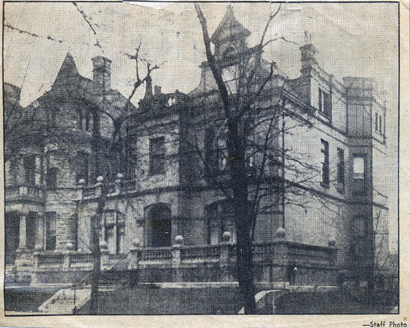 |
|
|
78 Vandeventer Place, St. Louis.
1930's newspaper photo. |
|
|
|
The family home at 78 Vandeventer Place could better be called a
small mansion. Mother described her childhood home in her 1995 tape
recorded oral
history interview as having 16 rooms including a ballroom upstairs.
Built in the 1870's or 1880's it still had gas-lights on the walls from
the days before electricity. It had 6 fireplaces, 3 downstairs
and 3 upstairs and a rifle shooting range in the basement. The
family employed 3 full-time live-in servants which included a cook, a
maid, and a combination driver, gardener, and butler. The Great
Depression which swept the U.S. in the 1930's apparently didn't effect the
Hulburd family. During the summer of 1936 19
year-old daughter Betty traveled to Europe for a month and a half and
saved the letters Dutch and Hazel wrote to her for pick up at various
American Express offices in European cities. At the
time Hazel was vacationing in New Hampshire with her other daughter,
Harriet, son Bud was at a summer camp, and Dutch was home in St. Louis working. The letters written
by Hazel are believed to be the only samples of her writings to have
survived and provide a glimpse of the life of leisure the Hulburd family
had come to enjoy.

 |
 |
 |
|
Dutch (Undated) |
Dutch, Betty, Hazel, and Harriet (c. 1925) |
Hazel
(mid-1930's) |
A Major Change
Life
had treated the Hulburd family well throughout the 1930's until late 1938
when all their lives were suddenly, significantly, and forever changed:
C. Earl Hulburd was caught embezzling money from his employer and would
end up in the state penitentiary. I have always been vaguely aware
that Grandpa Dutch had spent some time in prison but never knew why,
when, or for how long. My mother never really talked about her
father's imprisonment unless asked and then was vague on the details and
downplayed it. I've only recently learned exactly what happened and
come to understand the clearly devastating effect it had on the family.
When going through my
mother's effects (in 2002, 6 years after her death) I ran into a large
manila envelope containing perhaps 100 letters and documents Dutch had
saved relating to his investment in
Illinois oil wells. The letters cover the period from about 1930 to 1948.
Reading these suggested that Dutch had been an active part-time
investor in these wells and I noticed that some of the letters were
written from the Missouri State Penitentiary and contained his inmate
number. With this number and a reference in one letter that he had
entered prison around January of 1939, I contacted the Missouri Department
of Corrections and the St. Louis Courts to see if they had archived any
documents relating to Dutch's imprisonment. The St. Louis Courts
provided me with complete copies of his court records. Having
now obtained the exact court dates I was able to obtain copies of St.
Louis Post Dispatch newspaper articles relating to Dutch from the St. Louis
Public Library. The court records along with the newspaper articles
provide an very detailed picture of exactly what happened.
The following is a short summary of events. More
details including scans of all the documents I obtained can be found by
following the links which appear below. On December 23,1938,
while visiting a hospital to check on his son Bud who had just undergone
an appendectomy, Dutch confessed to a St. Louis Post Dispatch reporter
that for the past 10 years he had been systematically embezzling
approximately $2,000 per month from his employer, the Collier Estate, and
a related estate which he did work for. The accumulated amount taken was
in excess of $200,000, a small fortune in those days and at a time when his normal
annual salary was about $3,200. For 4 of the 5 days between Dec.
24th and Dec. 28th of 1938 the St. Louis Post Dispatch (the major newspaper in
town) ran large "above-the-fold" front page stories about
Dutch's embezzlement, primarily I suspect, because of the family's high
profile social standing in the city.
| |
 |
| Dutch and
Hazel in happier times |
| |
Immediately after the story
ran and against the wishes of his employer (who had discovered the
embezzlement the previous November but had not gone to the police),
Dutch was arrested and jailed. The family had evidently known for a
month and a half before the news became public and the newspaper indicates
that Hazel had spent this entire time sitting and staring mindlessly out
of a second story window of their home, seeing and talking to no one.
It's apparent that the Hulburds high standard of living and social status
were largely based on embezzled funds. The newspaper articles
indicate that my mother, Betty, who never let on in later years that she
knew any of the details of her father's incarnation, was present at some
of the police and court proceedings and had intimate knowledge of
everything that happened. Dutch's involvement in oil well
speculation was his way of attempting to earn enough to pay back the
embezzled funds before being discovered. There is no evidence that any of
his oil well investments ever paid off. In January of 1939,
without even retaining an attorney and after having signed all his
financial assets over to his former employer, Dutch plead guilty to
3 counts of "embezzlement by agent" and was sentenced to 10 years in the
Missouri State Penitentiary in Jefferson City. According to the
newspaper stories he just wanted to get it over with.
The shame
must have been unbearable to his family. There is no record of what
happened over the next several months but in a letter from jail to an oil
well venture associate Dutch wrote on September 2, 1939 from prison:
|
"I suppose you know the family is in New York. Harriet went
on about April 1st, Betty the first of August and Hazel left two
weeks ago. Bud spent the summer at camp in New Hampshire and
they grabbed him as he arrived in N.Y. They seem to be
temporarily settled and the next step is to find a suitable school
for Bud. I think the move is a wise one, particularly for
Hazel and Bud. As for me, things are not nearly as tough as
was anticipated and as soon as the family is straightened out I
shall be able to settle down to comparative comfort."
|
 |
I suspect that the
move to New York City was made because Hazel's daughters had both attended
Finch College there and thus had some connections and knowledge of the
area, and not because Hazel knew anyone there. To the best of my
knowledge all of Hazel's Coudy relatives were in the St. Louis area.
I have to assume that the primary reason for the move was not so much the
new location as it was to no longer be in St. Louis where the social
stigma now associated with Dutch's conviction must have been enormous and
unbearable.
The Final Years
Much of what I've learned about Dutch and Hazel's
later years has come from letters written by Dutch which were saved by
my mother.
Hazel
Hazel, along with daughters Betty and Harriet and son
Bud, took up residence in an apartment in New York City in 1939 (first at
140 E. 46th St and then in the fall of 1940 at 157 E. 46th St.).
Bud, a teenager at the time, attended school in the city and Betty and
Harriet took jobs to support the family which was otherwise
substantially destitute after having transferred most of it's assets to
Dutch's former employer as restitution. Hazel apparently
didn't work nor have any desire to, allowing her daughters to be the
bread winners in the family. Dutch's letters to Betty suggest that
Hazel remained somewhat depressed and not much interested in anything
during this period.
In 1940 Hazel filed for divorce from her husband.
Dutch didn't contest it and the divorce was finalized in December, 1940.
Apparently Hazel traveled to St. Louis that month for the final court
date. Mother had once told me that the divorce was necessary so
that Hazel could sell the home at 78 Vandeventer
Place however I find no evidence of this in either the newspaper
clippings about the divorce nor in Dutch's letters regarding it. I
suspect that the home, like all the other family assets, was sold or
transferred as part of the restitution effort and that Hazel just wanted
to put the part of her life involving Dutch behind her.
| |
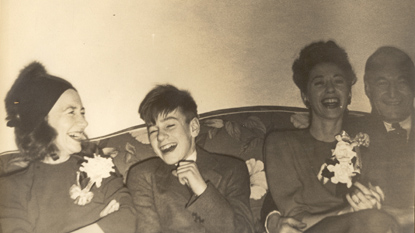 |
At the
February, 1942 wedding reception of daughter Betty.
From left to right: Hazel Coudy-Hulburd,
Bud Hulburd,
Harriet Hulburd-Erstein, Ben Erstein |
In the fall of 1941 Hazel's daughter Harriet married
Ben Erstein and moved elsewhere (but nearby) in New York City. Then in February of 1942
Betty married Kirt Hine and moved to northern New Jersey with her new husband not
far from New York City.
Hazel, Harriet and Bud attended Betty's New York City wedding and Bud
gave away the bride. For
the next 2 years Harriet and Betty (presumably with the help of their
respective husbands) apparently continued to support Hazel and Bud.
Bud started living with his sister Betty and Kirt Hine sometime in 1942,
probably in the fall when he entered Caldwell (NJ) high school (he
subsequently attended the near by Morristown School). It is not
known whether Hazel continued to live in the same New York City
apartment she had shared with Betty, Bud, and Harriet but it's possible
she moved elsewhere. My mother never mentioned that Hazel had
lived with the Hine family and Bud in New Jersey. Perhaps she
lived with Harriet and her husband Ben for a time.
Sometime around the first part of 1943 Hazel became
seriously ill and was hospitalized with what mother indicated was
diagnosed as a brain tumor (later reported in St. Louis newspapers as a
"nervous breakdown"). Hazel spent the next year in a New York
nursing home and passed away on February 22, 1944 at the age of 50.
In letters written to Betty from prison between 1940
and 1942 Dutch mentions and comments more than once on a fainting
problem Hazel was having in New York which was apparently getting progressively worse.
He mentions in one letter that Hazel had experienced her first
mysterious fainting spell about 10 year before and that these spells
continued occasionally over the years but were never considered serious.
Looking back at it one can easily conclude that Hazel's brain tumor had
effected her for a number of years but went undiagnosed due to the lack
of sophisticated medical technology at the time.
|
 |
Hazel's obituaries indicates that she was
buried in New York but my mother seemed to think (on recorded audio tape)
that her mother was buried in the Bellefontaine Cemetery in St. Louis
with Coudy relatives. In a recently discovered letter
written by Dutch to Betty in December of 1949 regarding the St. Louis
funeral of Hazel's father, Horace R. Coudy, Dutch writes:
"I had Mother's ashes placed inside the casket so
they are adequately cared for." Dutch regularly referred to Hazel
as "mother" in written communications with Betty thus suggesting that
Hazel was cremated and the ashes are in fact in Bellefontaine Cemetery,
St. Louis.
Dutch
Among my mother's possessions I recently came upon approximately 78
letters written by Dutch to her (and some to Bud) during the period
from September 1940 through July of 1942. There is no reason
to believe that there were not many more letters written before and
after these dates which for some reason were not saved or did not
survive 60 years of storage. From these letters it is clear that Dutch communicated
regularly with his family during his incarceration.
The letters are absolutely fascinating and provide an
awesome amount of insight into Dutch, his personality, his experience in
prison, and the trials and tribulations of the family in New York.
Dutch was clearly a gifted writer and most of these typed letters are
easy and fun reading. He spent his time in prison working in an
office as a clerk and apparently had unlimited access to
typewriters which he used often to write his frequent letters.
 The letters
reveal that Dutch primarily communicated with Hazel and Bud through
Betty. Apparently Hazel was not interested in communicating
directly with her ex-husband and also did not much want Dutch directly
communicating with Bud. So Dutch got around this by exchanging letters
with Betty (even though all the New York Hulburds were sharing the same
apartment). Dutch talks about his ongoing plans to get
out of jail early which, among other things, involved a letter writing campaign whereby he
got in excess of 65 of his influential St. Louis friends to write and
request an early release and commutation of his sentence. He also
discusses some of his childhood antics, his parents, life in prison, Missouri
politics of the day, and attempts (not terribly successfully) to help
run his family from his jail cell. He takes responsibility for
almost every problem the family faces, provides advice and emotional
support to his family, and expresses his deeply felt
desire to re-unite with young son Bud after serving out his sentence.
The letters also indicate that Dutch's parents,
Henry and Ella Hulburd visited him frequently in prison. They had
moved back to Moberly, Missouri after Henry retired. Moberly is
only about 60 miles from the penitentiary in Jefferson City which would
have made visits relatively easy.
Dutch is shown on a list of those attending the Moberly funeral
of his mother, Ella, in March of 1943. It is thus assumed
that Dutch was temporarily released in order to attend. Due
to their re-location to New York it is likely that Hazel, Betty,
Harriet, and Bud did not visit Dutch during his incarnation except
possibly in the first half of 1939 before their move east.
Dutch's campaign for early release from prison
apparently worked. In spite of being turned down at his first
hearing for parole or early release in the winter of 1941 he kept trying and
was released from the penitentiary on December 15, 1943 after serving
only 4 years and 11 months of his 10 year sentence. Records show
that he was granted a "conditional pardon" by the Missouri governor
which apparently meant that so long as he stayed out of trouble, he did
not have to go through the traditional parole process of having to
periodically check in with a parole officer, endure travel restrictions,
and deal with other issues usually associated with parole.
|
 |
|
 |
|
This photo of Dutch was labeled
1942. Since he was in prison at that time the photo is either mislabeled or for some
reason the photo was taken while he was incarcerated. |
|
Dutch (right), my father Kirt
Hine (center), and an unknown person (left) having
dinner at a fancy St. Louis restaurant. The photo was taken by the
professional
house photographer as evidenced by the folder containing it. It is
undated but
must have been taken in the late 1940's or early 1950's. I
have no recollection
of my entire family ever visiting St. Louis while Dutch was alive so I
suspect
that father was there on business. |
Dutch left prison in Missouri two months before the death of Hazel in New
York. There is no record as to whether Dutch visited his former wife
in the nursing home in New York during this period. World War II was
raging and cross country travel was difficult for those not in the
military. This, in addition to the fact that Dutch would have had
very little or no money upon his release, suggest that he likely did not
see Hazel again prior to her death.
After leaving prison Dutch
took up residence at a St. Louis boarding house (at 5077 Washington
Ave.) and went to work as a manager
for the Emerson Electric Company, a manufacturer of motors and other
electric items. Mother indicated and letters tend to confirm that in the late 1940's and early
1950's he visited our family in New Jersey "every Christmas and sometimes
in between".
His son Bud moved back to St. Louis and attended
school there for the 1944/45 school year but evidently didn't
like the school much and went back to New Jersey to finish high school at
the Morristown School the following school year. After high school and a 3 year enlistment in the
Marine Corps Bud again returned to St. Louis to live with his father in the
fall of 1949. Shortly after taking the entrance exams to attend
Washington University (St. Louis) Bud was tragically killed in a small airplane crash along with
his flight instructor in March of 1950. Dutch apparently spent most
of the years after leaving prison living alone at the boarding house and
the loss of his son who he so much wanted to be re-united with while in
prison must have been devastating.
Dutch passed away
on February 2, 1952 at age 63 due to a heart attack, a little more than 8
years after leaving prison. According to
correspondence after his death between a St. Louis attorney who handled
Dutch's affairs and my mother, Dutch was walking on the sidewalk near his
boarding house where witnesses indicated he suddenly fell. He was
taken to a hospital where he was pronounced dead on arrival. The
post mortem examination concluded that the cause of death was coronary
occlusion and coronary sclerosis.
The same correspondence between the attorney and
Betty indicates that Dutch had had a heart attack about 2 years before
his death. Found among mothers papers was a two page list typed by
Dutch and sent to her on May 23, 1950, apparently with a copy of his will
(which is missing), in which he outlines his possessions, financial
condition, and location of important papers (see the link below to "Dutch's
Misc. Surviving Writings" to view the list). It's clear that he was anticipating
his possible death which didn't happen for another year and three
quarters. The list suggests that Dutch had no significant
financial assets except for a car he was making payment on.
He indicates that he was financially living day-to-day.
Dutch was cremated and
his remains buried in the Hulburd-Knowles family plot with his parents and
other ancestors in
the Oakland Cemetery in Moberly, Missouri, the town of his birth.
A final note:
Dutch did however leave a small amount of Emerson Electric stock (his last
employer) to his daughters. Mother indicated several times over the
years that her father had often said to never sell this stock as it was a
good company and the stock would grow significantly in value.
Emerson Electric in fact has done well over the past 50 years and as I
write this I still own a few shares of its stock left to me when my
mother passed away.
Copyright 2004, Edward K. Hine, Jr. |